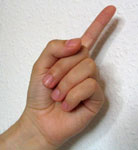1 (number) facts for kids
Quick facts for kids
|
||||
|---|---|---|---|---|
| Cardinal | one | |||
| Ordinal | 1st (first) |
|||
| Numeral system | unary | |||
| Factorization | 1 | |||
| Divisors | 1 | |||
| Greek numeral | Α´ | |||
| Roman numeral | I | |||
| Roman numeral (unicode) | Ⅰ, ⅰ | |||
| Greek prefix | mono- /haplo- | |||
| Latin prefix | uni- | |||
| Binary | 12 | |||
| Ternary | 13 | |||
| Senary | 16 | |||
| Octal | 18 | |||
| Duodecimal | 112 | |||
| Hexadecimal | 116 | |||
| Greek numeral | α' | |||
| Persian | ١ - یک | |||
| Arabic | ١ | |||
| Urdu | ||||
| Ge'ez | ፩ | |||
| Bengali & Assamese | ১ | |||
| Chinese numeral | 一,弌,壹 | |||
| Korean | 일, 하나 | |||
| Devanāgarī | १ | |||
| Telugu | ೧ | |||
| Tamil | ௧ | |||
| Kannada | ೧ | |||
| Hebrew | א (alef) | |||
| Khmer | ១ | |||
| Thai | ๑ | |||
| Malayalam | ൧ | |||
| counting rod | 𝍠 | |||

One (1) is a natural number. It comes right after zero and before two. It helps us count a single item or thing. For example, a person usually has one head, one nose, and one mouth. The Roman numeral for one is I.
The Number One in Math
In mathematics, the number 1 is very special. It's known as the "multiplicative identity." This means that when you multiply any number by 1, the number stays the same. It's also the only number with these unique features:
- If you multiply any number n by 1, the answer is always n. For example, 7 × 1 = 7.
- If you divide any number n by 1, the answer is always n. For example, 7 / 1 = 7.
- If you divide any number n (except 0) by itself, the answer is always 1. For example, 7 / 7 = 1.
- You cannot divide 1 by any other natural number (except 1 itself) and get another whole natural number as the result.
The Number One in Computers
The number one is very important in computer science. This is because computers use the binary system, which only uses two numbers: 1s and 0s. In machine code and many programming languages, the number one often means "true" or "on," while zero means "false" or "off." This simple system helps computers process information.
Related Pages
See also
 In Spanish: Uno para niños
In Spanish: Uno para niños

